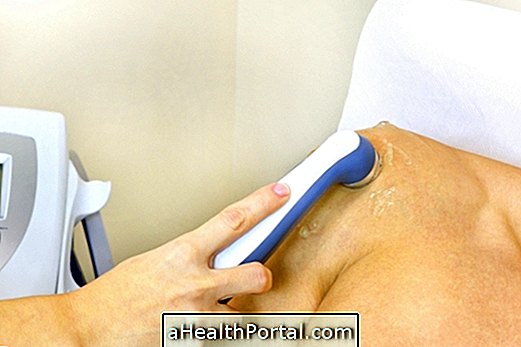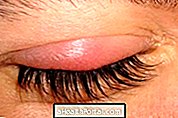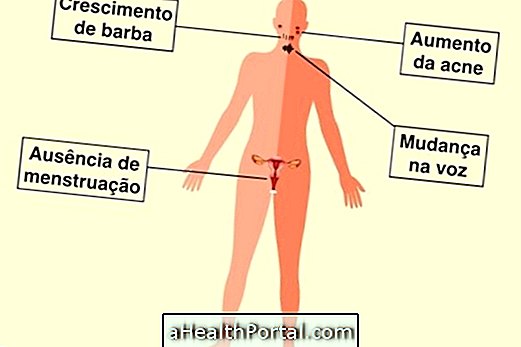To care for a person who has been bedridden due to surgery or a chronic illness, such as Alzheimer's, for example, it is important to ask the nurse or doctor in charge for basic instructions on how to feed, clothe or bathe the patient to avoid aggravation of the disease and improve their quality of life.
In this way, to keep the patient comfortable and at the same time prevent wear and pain in the caregiver's joints, here are some simple tips for lifting, turning, changing the diaper, feeding and bathing the bedridden patient.
Primary care with the bedridden person
The most important care to treat the bedridden person is related to hygiene, feeding, comfort and elimination of feces and urine.
Watch these videos to learn the step-by-step techniques:

1. How to take care of personal hygiene
The hygiene of the bedridden person is important to avoid the accumulation of dirt that can lead to the development of bacteria, worsening the state of health. Thus, the care that should be done include:
- Give bath at least every 2 days. Learn how to bathe a bedridden person;
- Wash your hair at least once a week. Here's how to wash the hair of a bedridden person;
- Change clothing every day and whenever it is dirty;
- Change the sheets every 15 days or when they are dirty or wet. Here's an easy way to change the bed sheets of a bedridden person;
- Brush your teeth at least 2 times a day, especially after eating;
- Cut the nails of the feet and hands once a month or whenever necessary.
Hygiene care should only be done in bed when the patient does not have enough strength to go to the bathroom. When cleaning the bedridden person, be aware of any skin or mouth sores, informing the nurse or the doctor accompanying the patient.
How to deal with urine
The bedridden person usually 4 to 6 times a day, so when conscious and able to hold the pee, she is able to ask to go to the bathroom. If she can walk, she should be taken to the bathroom. In other cases, it should be done in the comadre or in a urinal.
Even when the person is not conscious or has urinary incontinence, it is recommended to use a diaper that must be changed whenever it is wet or dirty. In the case of urinary retention, the doctor can advise the use of a bladder catheter that must be kept at home and requires special care. Learn how to care for the person with a bladder catheter.
How to handle stool
Faecal elimination may change when the person is bedridden, and is generally less frequent and with more dry stools. Thus, if the person does not evacuate for more than 3 days, it can be a sign of constipation and it may be necessary to massage the belly and offer more water or give a laxative under medical supervision.
2. How should the food be
The bedridden should be fed at the same time that the patient used to eat, but should be adapted according to his / her health problems. To do this, the doctor or nutritionist should be asked about the foods that should be given preference.
Most patients are able to chew food and therefore only need help to get food to the mouth. However, if the person has a feeding tube it is necessary to take some special care when feeding. Here's how to feed a person with a catheter.
In addition, some patients may have difficulty swallowing food or liquids, so it may be necessary to adapt the consistency of the dishes to the capabilities of each. For example, if a person has difficulty swallowing water without choking, a good tip is to offer gelatin. When the person can not swallow solid foods, one should give preference to potatoes or "pass" the food to make them more pastey.
3. How to maintain the comfort of the bedridden person
The comfort of the bedridden person is the main objective of all the above mentioned care, however, there are other care that help to keep the person more comfortable, without hurting or with less pain and which include:
- Turn the person at the most every 3 hours to avoid the appearance of bedsores on the skin. Find out how to become a bedridden person;
- Lift the person up whenever possible, allowing you to eat or watch television with family members in the room, for example. Here is a simple way to raise a bedridden person;
- Exercise with the patient's legs, arms and hands at least 2 times a day to maintain joint strength and range. See the best exercises to do.
It is also recommended to keep the patient's skin well moisturized, to stretch the sheets well and to take other care that prevents the appearance of wounds on the skin.
When should you go to the doctor?
It is recommended to call the doctor, consult a general practitioner or go to the emergency room when the person in bed presents:
- Fever above 38 ° C;
- Skin wounds;
- Urine with foul blood or odor;
- Stools with blood;
- Diarrhea or constipation for more than 3 days;
- Absence of urine for more than 8 to 12 hours.
It is also important to go to the hospital when the patient refers to many strong pains in the body or is very agitated, for example.

























